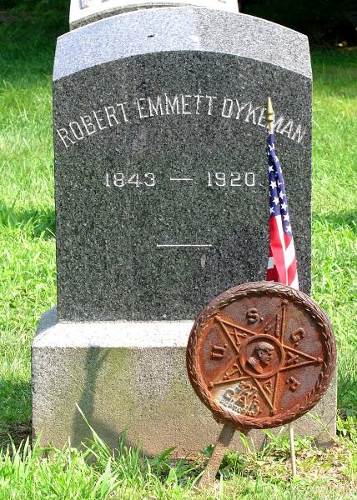DUNCAN, GEORGE (1830-1908). Sergeant, 8th Regiment, New York State Militia, Company H. Born in New York State, he enlisted as a sergeant in 1861 to serve three months, and mustered into the 8th Regiment. As per the censuses of 1880 and 1900, he was a carpenter. He applied for and was granted a pension in 1896, certificate 924,303. Duncan last resided at 422 West 20th Street, Manhattan. Duncan died from apoplexy. His widow, Harriet M. Duncan, who is interred with him, filed for and received a pension in 1908, certificate 653,428. Section 2, lot 7880, grave 3.
Civil War Bio Search
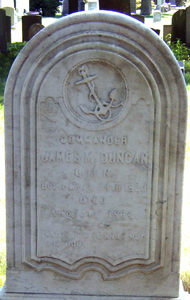
DUNCAN, JAMES M. (1820-1864). Commander, United States Navy. A native of Madisonville, Ohio, he was 6′ 2″ tall with brown eyes, brown hair and a light complexion. Duncan entered the Navy as a midshipman on December 8, 1837, rose to master on April 9, 1851, and to lieutenant on December 2, 1851. During 1861, he was in command of the USS Norwich, a wooden screw steamer which participated in the South Atlantic Blockading Squadron near Savannah, Georgia. Duncan was promoted to commander on July 16, 1862. In June 1864, while aboard the USS Paul Jones on blockade duty off the coast of South Carolina, he took sick, was declared unfit for duty and sent home. The medical report, dated June 11, 1864, notes that Duncan had been suffering from dyspepsia, asthma, and gout, had difficulty walking and sleeping, and had become emaciated. He died “in the line of duty” at home in Brooklyn in August 1864 of rheumatic pericarditis. In all, he served nineteen years and ten months on sea duty and four years and seven months on shore duty.
As per his obituary in the New York Daily Tribune, he was a Freemason; members of his lodge and Navy and Marine Corps officers were invited to his funeral. He last lived at 75 1st Place in Brooklyn. His tombstone is inscribed, “Watch For Ye Not Know The Hour.” His widow, Mary Duncan, received a pension from the Navy, certificate 1,577. Section 149, lot 16757.
DUNCAN, JOHN A. (1842-1889). Sergeant, 145th New York Infantry, Company I. Enlisting as a corporal on August 13, 1862, at his birthplace, New York City, Duncan mustered into the 145th New York on September 16. During his service, he rose to sergeant on April 10, 1863, and mustered out on January 14, 1864.
As per the 1880 census and the 1885 Brooklyn Directory, he was a carpenter by trade. According to his obituary in the Brooklyn Daily Eagle, he was a member of Cushing Post #231 of the G.A.R. He last resided at 292 Court Street in Brooklyn. The cause of death is listed as “perityphilitis asthenia.” Members of his G.A.R. Post and members of the Ladies Aid from that post were invited to attend his funeral. Sarah Duncan, who is interred with him, applied for and received a widow’s pension in 1891, certificate 213,319. Section 6, lot 20118, grave 967.
DUNHAM, JAMES H. (1838-1867). Private, 4th New York Light Artillery; 15th New York Light Artillery. Dunham, who was born in Bedford, New York (although one document says Connecticut), enlisted as a private at New York City on September 22, 1862, and mustered immediately into the 4th New York Light Artillery. He was 5′ 5″ tall with grey eyes, brown hair and a dark complexion. He was transferred into the 15th New York Light Artillery on December 12, 1863, and discharged from Convalescent Camp in Virginia on an unstated date. His last address was 176 West 37th Street in Manhattan. He died of consumption. Section 165, lot 17264.
DUNHAM, JOHN BARCLAY (1848-1886). Private, 66th New York Infantry, Company H. Enlisting on January 15, 1864, at New York City as a private, he mustered that day into Company H of the 66th New York. He mustered out on August 30, 1865, at New York City. His last residence was in Mount Vernon, New York. Dunham succumbed to Bright’s disease. Section 83, lot 2367.
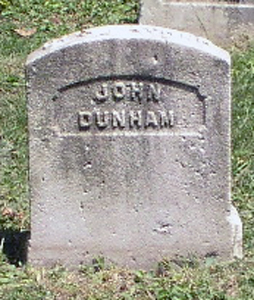
DUNHAM, JOHN E. (1835-1873). Second lieutenant, 5th New York Infantry, Companies B and E. Dunham, a book-keeper by trade, was the nephew of a prominent piano manufacturer. After enlisting at New York City as a first sergeant on April 25, 1861, he mustered into Company B of the 5th New York on May 9. Accidentally wounded in the head on June 18 at the Battle of Big Bethel, Virginia, he advertised his offer to bring parcels and letters to soldiers in his regiment when he returned to action. He was promoted to second lieutenant on September 15, 1861, effective upon his transfer to Company E on that date, and resigned on February 6, 1862. Davenport, in his history of the 5th New York noted that Dunham “recovered physically but not mentally” from his head injury.
Dunham’s life came to a tragic end at a Harlem saloon, when he, a confirmed drunk, refused to pay the owner, Frederick Kerker, for his thirty cent lunch. Kerker and the cook beat Dunham, who fled to the street, fell on the pavement and sustained a fatal fracture to his skull. He died at Reception Hospital on 99th Street in Manhattan and last resided in Yonkers, New York. Section 83, lot 1214.
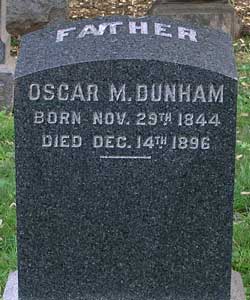
DUNHAM, OSCAR M. (1844-1896). Private, 61st New York Infantry, Company H. Born in New York City, he lived in West Farms, New York (Westchester County), according to the 1860 census. During the Civil War, he enlisted at New York City on October 17, 1861, mustered into the 61st New York two days later, and was discharged on November 11, 1861.
He is likely the Oscar M. Dunham who is listed as a manager in the 1876-1878 and the 1877 New York City Directories; the latter directory shows him living in New Jersey. The census of 1880 indicates that he was a publisher living in Jersey City, New Jersey. At the time of his passport application in 1882, he was 5′ 8½” tall with blue eyes, long face, round chin, small mouth, chestnut hair and a light complexion. The 1882-1883 and 1889-1890 New York City Directories list him as a manager; the former directory notes that he was living in Jersey City. At some point, he resided in Milwaukee, Wisconsin, and was in Vancouver, British Columbia, at the time of his death.
As per an article about his death in the New York Tribune on January 7, 1897, Dunham had been the president of Cassell Publishing in New York City but fled to Canada in June 1893 after he was caught in a swindling scheme. He had been speculating unsuccessfully on Wall Street and then embezzled more than $160,000 from his firm to cover his losses. Dunham lived in Vancouver under an assumed name, worked in the mines there, and then turned to prospecting. He lost his leg in a mining accident a month before he died, and blood poisoning set in. Dunham revealed his true identity on his death bed, summoned his wife who was living in Reading, Pennsylvania, but died and was buried before she arrived. His body was exhumed and identified so that she could obtain his life insurance. It was then re-interred at Green-Wood. Section 189, lot 19452, grave 6.
DUNKLE, CHARLES WATSON (1836-1919). Private, 18th New York Infantry, Company G. Born in Hopewell, New York, Dunkle enlisted as a private at Canandaigua, New York, on October 29, 1861, and mustered into Company G of the 18th New York that same day. He mustered out with his company on May 28, 1863, at Albany, New York. As per his obituary in the New Rochelle Pioneer [New York], which confirms his Civil War service, Dunkle returned home from the hostilities uninjured.
After the Civil War, he relocated to Chicago, Illinois, and was active in politics there. He was also a member of the George W. Thomas Post of the G.A.R. and a life member of the Freemasons in that city. He lived the last nine years of his life in New Rochelle, New York, where he belonged to St. John’s Church. His funeral was held at the home of his daughter who also lived in New Rochelle. His death was attributed to nephritis. He was survived by his daughter and two sons, one of whom lived in Chicago. As per his obituary in the New York Herald, Chicago papers were asked to print a notice of his death. Section 97, lot 4016.
DUNKLY, GEORGE R. (1838-1934). Acting second assistant engineer, United States Navy. Dunkly, who was born in New York City, enlisted as an acting third assistant engineer in the United States Navy on November 18, 1861, and was discharged on January 22, 1864, as an acting second assistant engineer. The 1876 Brooklyn Directory lists him as an engineer as does the 1880 census. As per the census of 1910, he was an engineer at a factory; he was not working in 1915 or in 1925. He was a member of Ulysses Grant Post #327 of the G.A.R. According to his obituary in The New York Times, which confirmed his Civil War service as a Navy lieutenant, he was also a member of the Odd Fellows. Dunkly received a pension from the Navy, certificate 33,386. He lived at 165 Adelphi Street in Brooklyn for 80 years. He died at the age of 96 from arteriosclerosis. Section 196, lot 31370.
DUNLOY, JAMES D. (1836-1885). Sergeant, United States Marine Corps. A native of Ireland, Dunloy enlisted as a private on May 4, 1858, and served in the United States Marine Corps until he was honorably discharged on May 1, 1862. He immediately re-enlisted as a sergeant and served in the Marine Corps throughout the Civil War until his discharge on May 9, 1866.
According to an article in the Brooklyn Daily Eagle on March 11, 1867, Dunloy had pleaded “not guilty” to two crimes, one of removing spirits from a distillery and the other, of fraudulently branding barrels of whiskey with the inspector’s stamp. In both cases, he posted bail. As per censuses of 1870 and 1880 and the 1876 Brooklyn Directory, he was a watchman at the Navy Yard. He joined William Rankin Post #10 of the G.A.R. on July 20, 1881. His last residence was on Cumberland Street in Brooklyn. The cause of his death was phthisis. In 1891, Rebecca Dunloy, who is interred with him, applied for and received a widow’s pension from the Navy, certificate 5,082. On May 23, 1892, the Brooklyn Daily Eagle had an article about the members of the Rankin Post decorating the 26 graves of its comrades who served in the Civil War and were interred at Green-Wood; among the names, with a description of their service, was James Dunloy. Section 201, lot 25081.
DUNN, DAVID (1836-1891). Private, 10th New York Infantry, Company F. Of Irish origin, he enlisted on March 18, 1864, served in the 10th New York, and was discharged on June 29, 1865. Dunn’s military service was confirmed by the Brooklyn Veterans Schedule of 1890. His application for an invalid pension was granted in 1890, certificate 694,791. He last resided at 441 17th Street in Brooklyn. Dunn died from chronic bronchitis. Delia Dunn applied for and was granted a widow’s pension in 1891, certificate 318,904. Section 206, lot 27211, grave 42.
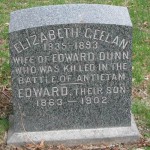
DUNN, EDWARD (1831-1862). Corporal, 63rd New York Infantry, Company I. After enlisting as a private on August 21, 1861, at New York City, Dunn mustered immediately into Company I of the 63rd New York where he was promoted to corporal at some point. He was killed in action at the Battle of Antietam on September 17, 1862, an event inscribed on the tombstone of Elizabeth Geelan, his widow. She filed for a pension in 1862, certificate 3,484. The gravestone indicates that their son, Edward, who is interred with his mother, was born in 1863. It is unclear where Edward Dunn, the Civil War veteran, is buried. Section 132, lot 34533.
DUNN, MICHAEL (1825-1892). Private, 37th New York Infantry, Company C. Born in Brooklyn, Dunn enlisted as a private on May 14, 1861, at New York City, mustered into the 37th on June 7, and mustered out on June 22, 1863, at New York City. He last lived in Brooklyn at the Home of Industry. His death was attributed to apoplexy. Section 6, lot 20118, grave 111.
DUNN, TIMOTHY (1841-1868). Private, 25th New York Infantry, Company H; petty officer, first class, United States Navy. Originally from Canada, Dunn enlisted as a private at New York City on May 13, 1861, and mustered into the 25th Infantry on June 26. As per his muster roll, he was paid by New York State $14.40 from May 17 through June 17, 1861. He deserted on September 6, 1862, at Alexandria, Virginia. Subsequently, Dunn enlisted in the United States Navy at New York City in June 1863. At that time, he was a 6′ 3¼” laborer with a dark complexion. He entered the Navy Hospital from the USS Vermont on May 25, 1865, suffering from a vulnus contusum (crush wound) and was discharged from the hospital on June 17, 1865.
An article in The New York Times on November 22, 1868, headlined, “Suicide or Homicide,” reported on the controversial aspects of Dunn’s death. He had been found delirious and bleeding at his store, a syrup and cordial business, at 2½ Morris Street and died the next day at New York Hospital. At first, his death appeared to be a suicide but then the coroner began an inquest to determine if it was a homicide. Dunn’s partner, Matthew English, testified that he last saw Dunn at 9:00 a.m. when he was about to clean the kegs and when he returned at 11:00 a.m., the store was closed. English then returned at 4:00 p.m. with his son and found the door ajar with Dunn sitting near a stove apparently asleep. His son, John English, then discovered that Dunn was bleeding with a pistol in his lap. Matthew English testified that he kept the loaded gun at the store and that the partners had no disputes. Dunn wanted to sell his share of the business and move South; the financial status of the enterprise was described as “middling.” John English corroborated his father’s words. A neighbor whose apartment adjoined the store testified that she heard two pistol shots about 2:00 p.m. and that at about noon she had seen a man rapping on the store’s door. The final testimony came from the police officer who English summoned. The officer noted that Dunn had sustained a pistol shot to his right temple resulting in the burning of Dunn’s hair near the gunshot. The inquest was scheduled to be resumed; its outcome is unknown. He last lived at 42½ Hamilton Street in Manhattan. Section 127, lot 3611, grave 345.
DUNNELL, GEORGE H. (1839-1887). Private, 7th Regiment, New York State National Guard, Company I. Born in New York, Dunnell was a clerk as per the 1860 census. He enlisted and mustered into the 7th Regiment at New York City on May 25, 1862, and mustered out after three months on September 5, 1862. According to the census of 1870, he was an insurance clerk living in Union Township, New Jersey, with a personal estate worth $1,000. The census of 1880 and the Jersey City Directory of 1881 indicate that he was a clerk. Adele Dunnell, his widow, confirmed that her husband served in the Civil War on the 1890 Veterans Schedule. In 1890, Adele O. Dunnell applied for and received a widow’s pension, certificate 349,922. He last lived at 342 West 18th Street in Manhattan. Section ?, lot ?.

DUNNING, THOMAS (1833-1914). Private, 127th New York Infantry, Company B. Dunning was born in New York City. He enlisted on August 15, 1862, and mustered into the 127th New York on September 8. A clerk, he was 5′ 8″ tall with gray eyes, dark hair and a dark complexion. As per his muster roll, he was detailed to the Provost Marshal’s Office at Beaufort, South Carolina, as of October 7, 1864. He mustered out on June 30, 1865, at Charleston, South Carolina.
As per the 1869 Brooklyn Directory and the 1870 census, Dunning was employed as a clerk. The Veterans Schedule of 1890 confirms his Civil War service. In 1891, he successfully applied for an invalid pension, certificate 765,453. He was still working as a clerk in 1892. According to the 1910 census, his occupation is listed as “own income.” He last lived at 1609 Avenue H in Brooklyn. Arteriosclerosis was the cause of his death. Ann Dunning, who is interred with him, applied for and received a widow’s pension in 1914, certificate 787,182. Section 128, lot 31394, grave 555.
DUNNINGTON, STEPHEN A. (1845-1873). Sergeant, 23rd Virginia Infantry, Company G, Confederate States of America. Dunnington was interred at Green-Wood on January 19, 1873, and was removed from the cemetery on March 25, 1873. A native of Tollersville, Virginia, Dunnington was a student according to the census of 1860. Educated at Piedmont Academy and Frederick Hall, one record states that he left school to become a drummer boy in the Confederate Army. However, his soldier history states that he enlisted as a private at Fredericks Hall, Virginia, on April 24, 1861, and immediately mustered into Company G of the 23rd Virginia Infantry. He was listed as sick on September 15 of that year at Monterey, Virginia, but returned to his company and was promoted to sergeant on October 15. After he was wounded at Sharpsburg, Maryland, at the Battle of Antietam, on September 17, 1862, he returned to service, still injured, on or about August 16, 1863. First detailed as a clerk by General Robert E. Lee to Chimborazo Hospital in Richmond, Virginia, on October 3, 1863, for service as a hospital guard or other light work, he returned to duty on December 25. In a letter written from Chimborazo Hospital to Confederate Secretary of War James A. Seddon, in which he asked for a promotion to lieutenant, Dunnington wrote:
I have been disabled from wounds to the right shoulder received at battle of Sharpsburg and detailed on account of this disability for light service and assigned to duty at Chimborazo Hospital-
I am proud to say that I participated in every engagement of my Regiment previous to my being disabled. First, beyond the blue mountains of Virginia, under the gallant Garnett, then in the veteran division of our beloved, honoured and immortal Jackson. The long and weary marches, hardships and fierce engagements of that Hero are as familiar to the Hon Sec as to myself. Any conduct in those engagements I most respectfully beg permission to refer the Hon Sec to the accompanying recommendation-
Regretting the misfortune which has deprived our country of my services in the field, and knowing the hardship that has been manifested by you towards those who have endeavored to discharge their duty–I most respectfully submit this application to your kind consideration abiding by, cheerfully and willingly, any decision that the Hon Sec shall think proper to render-
The aforementioned accompanying recommendation from Captain Samuel Rice of the 23rd Virginia in support of Dunnington’s request for promotion to junior second lieutenant under General Order No. 86 noted, “He has been conspicuous for gallantry in several engagements of the war and was severely wounded at the Battle of Sharpsburg that though now with the company he is not able to handle a musket.” Another recommendation from J.M. Bennis of the same regiment said, “…at Battle of Sharpsburg which fractured the clavicle and rendered the right arm partially unmovable but his will not in my opinion prevent him from performing the duty of 2nd Lt.” He was later detailed to the signal corps (with rank of second sergeant), Gordon’s Division, on June 12, 1864, by Major General Joseph Johnston and returned to the 23rd on December 15, 1864.
The 1870 census and the 1872 New York City Directory indicate that he was in the ice cream business. Dunnington & Emigh advertised “Celebrated Philadelphia Ice Cream” in The Statesman, a newspaper from Yonkers, New York, on July 7, 1870, at $2 a gallon or 60¢ a quart. (The business was originally owned by his wife’s family, and known as Jacob Fussell & Co.) On July 2, 1872, he obtained a patent for a “refrigerator.” As per his death certificate, he was a manufacturer. He died in New York City at 45 Sixth Avenue, Manhattan. His death was attributed to consumption. After his remains were removed from Green-Wood, he was re-interred at Laurel Hill Cemetery in Philadelphia, Pennsylvania.
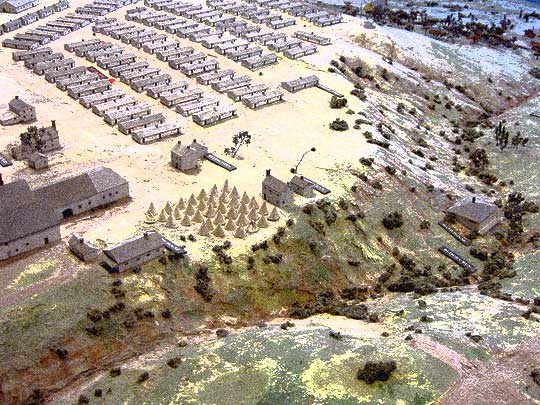
DUPIGNAC (or DIPIGITAC), GEORGE W. (1828-1876). Private, 1st New York Mounted Rifles, Company E; 4th New York Provisional Cavalry, Company E. Dupignac was born in New York. After enlisting as a private at New York City on August 7, 1862, he mustered immediately into the 1st New York Mounted Rifles. He re-enlisted on September 1, 1864, and subsequently transferred into the 4th Provisional Cavalry on September 6, 1865, from which he mustered out on November 29, 1865, at City Point, Virginia. He worked at Blackwell’s Island Penitentiary in New York City as an assistant keeper. His pension application in 1890 was approved, certificate 739,032. He last lived at 662 Greenwich Street in Manhattan. His death was caused by consumption. Section 62, lot 2842.
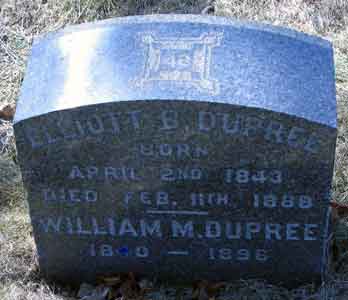
DUPRE (or DUPREE), ELLIOTT (or ELLIOT) B. (1843-1888). Corporal, 48th New York Infantry, Company A. Dupree, who was born in Connecticut, enlisted as a corporal at Brooklyn on July 5, 1861, and mustered into his company on August 21, 1861. During his service, he was reduced in rank to private before he was discharged on September 16, 1864.
As per the Newark, New Jersey Directory for 1871 and the Brooklyn Directory for 1878, he was a chiropodist (foot doctor). On February 6, 1878, an article in the New York Herald detailed a family scandal. Dupree, who traveled as a chiropodist, hadn’t communicated with his wife since December 20, 1877. She was destitute and needed money to support her young children. Dupree was described as 5′ 11″ tall with light brown hair and moustache and dark eyes. The Evening Telegram of March 31, 1880, noted that she obtained a divorce. Most likely, he was the brother of John Dupree (see). He last lived in Altoona, Pennsylvania. Emma W. Young applied for and was granted a widow’s pension in 1917, certificate 873,627. Section 4, lot 21316, grave 209.
DUPREE, JOHN A. (1841-1906). Wagoner, 48th New York Infantry, Companies E and A; private, 62nd New York Infantry, Company B. Dupree was born in Connecticut. After he enlisted at New York City as a private on June 1, 1861, Dupree mustered into Company B of the 62nd New York on June 30, and deserted a month later on July 30. He enlisted again at Brooklyn as a private on August 26, 1861, and mustered into Company E of the 48th New York the following day. He was promoted to wagoner, transferred to Company A, and was discharged on September 22, 1864. Most likely, he was the brother of Elliott Dupree (see) because the two had the same address on the 1863 New York Draft Registration data.
According to the 1880 census, he was living in Brooklyn and was employed as a paper agent. In 1890, his application for an invalid pension was granted, certificate 787,182. Dupree was a member of the G.A.R.’s Ulysses S. Grant Post #327 in Brooklyn. He last lived at 147 Bond Street, Brooklyn. Dupree succumbed to apoplexy. Section 137, lot 30305, grave 2.
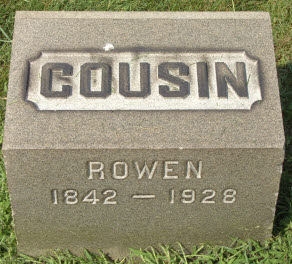
DURACK, ROWEN P. (or ROWEN, DURACK P.) (1842-1928). Private, 13th New York Cavalry, Companies I and K; 3rd New York Cavalry, Company K. Listed incorrectly on the muster rolls by the name, Durack P. Rowen, he enlisted on November 24, 1863, at New York City, and mustered that day into the 13th New York Cavalry. He was transferred into the 3rd New York Cavalry on August 17, 1865, and mustered out the next month on September 21 at Camp Barry, Washington, D.C.
According to a descendant, Durack moved to Milwaukee after the Civil War. His family received one post card from him: “I am in Milwaukee where the principle industry is brewing beer, and my principal industry is consuming the industry.” He applied for and received an invalid pension, certificate 665,802. Durack died at the National Soldier’s Home in Togus, Maine. In a codicil to his will, he expressed a wish that was fulfilled, that information about his military service be recorded on his tombstone. Section 193, lot 33220, grave 4.

DURANT, THOMAS C. (1820-1885). Railroad magnate and financier. Originally from Lee, Massachusetts, Durant was a graduate of Albany Medical College, class of 1840. He briefly served there as an assistant professor of surgery. Although he left medicine for a career in business and finance, he used the honorific “doctor” throughout his life. After serving as a director of his uncle’s grain exporting company, he saw the need for improvements in transportation and made his fortune in the railroad industry. He first became involved in the transportation business when he raised capital and oversaw the construction of the Mississippi and Missouri Railroad in 1853. When the railroad was sued by ship owners after hitting a bridge that he constructed across the Mississippi River, Durant hired an attorney, Abraham Lincoln, to defend the railroad. A further connection to the President was established through Grenville Dodge of Council Bluffs, Iowa. Dodge was a general in the Civil War who helped Durant amass a fortune through smuggled Confederate cotton.
Durant’s ties to Dodge and Lincoln became the foundation of his notoriety. When the Transcontinental Railroad was authorized in 1862, President Lincoln awarded the contract to the Union Pacific, for which Dodge had made the case that Council Bluffs be its eastern terminus. Known as a ruthless businessman, Durant was deeply involved in the Credit Mobilier scandal. The Credit Mobilier Construction Company was a complex scheme devised by Durant whereby the Union Pacific stockholders paid themselves rather than outside construction companies to build the Transcontinental Railroad and gave or sold stock to influential politicians in return for favors. The Union Pacific charged the railroad tens of millions of dollars more than the cost of its construction. When all was said and done, Durant and his cronies made off with at least $23 million; the railroad was nearly bankrupt and left to answer for the scheme when it was uncovered in 1872. A fellow in the American Society of Civil Engineers, he spent the last years of his life fighting lawsuits from angry investors and partners. He died from peritonitis. Section H, lot 10399.
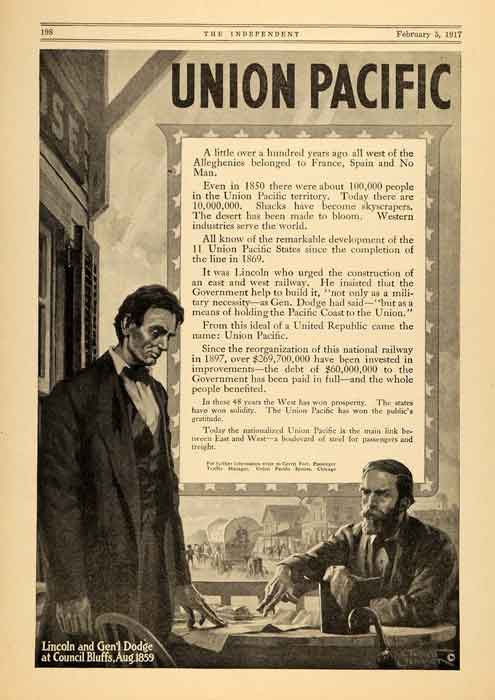
DURBROW, JEFFERSON (1825-1875). Private, 37th Regiment, New York State National Guard, Company F. Born in New York City and a seaman, Durbrow enlisted at New York City as a private on May 29, 1862, the same day that he mustered into the 37th Regiment. As per his muster roll, he was 5′ 7″ tall with blue eyes, light hair and a fair complexion. Three months later, he mustered out at New York City on September 2. Durbrow was a master mariner living in San Francisco, California, according to the census of 1870. He was the brother of Washington Durbrow (see) and Stephen Durbrow (see). His last years were spent as a resident of The Sailors Home in Snug Harbor, Staten Island. His death was attributed to typhoid fever. Section 27, lot 11209.
DURBROW, STEPHEN A. (1837-1876). Private, 37th Regiment, New York State National Guard, Company B. Durbrow, who was born in New York State, was in the carriage trade according to the 1857 New York City Directory. He enlisted at New York City as a private on May 29, 1862. On that date, he mustered into Company B of the 37th’s National Guard and mustered out after three months on September 2 at New York City. After his military service, he returned to his carriage business at 558 Broadway in Manhattan according to the 1869 New York City Directory. He was the brother of Jefferson Durbrow (see) and Washington Durbrow (see). His last residence was 228 East 30th Street in Manhattan. Durbrow died from Bright’s disease. Section 27, lot 11209.
DURBROW, WASHINGTON (1843-1894). Captain, 40th New York Infantry, Companies F, B, and K; second lieutenant, 83rd New York Infantry, Company D. A New Yorker by birth, Durbrow was 5′ 9″ with light complexion, brown hair and blue eyes. He enlisted at New York City as a private on April 27, 1861, and mustered into the 83rd that day. On December 12, 1862, he was wounded at Fredericksburg, Virginia, a Minie ball entering his right groin and lodging next to the spine. He was taken to Lincoln Hospital at Washington, D.C., the same day, but the bullet was not removed. He was promoted to second lieutenant on December 31, 1862, the day that he was discharged for promotion. After returning to New York in January 1863, for medical treatment, the ball was found to have been flattened to a semi-lunar shape. It was extracted with much difficulty, and he remained under doctor’s care until mid-March.
He was transferred into Company F of the 40th New York with the rank of corporal on January 1, 1863, was promoted to second lieutenant that day, and rose to first lieutenant on March 31 of that year effective upon his transfer that day to Company B. Durbrow became captain on June 6, 1863, and was transferred to Company K that day. He was captured in action on May 12, 1864, at Spotsylvania Court House, Virginia, and was held in Confederate prisons at Macon and Savannah, Georgia; Charleston and Columbia, South Carolina; and at Charlotte, North Carolina. He escaped from Charlotte on February 17, 1865, and suffered exposure and hardship while crossing the mountains in winter returning to his regiment at Knoxville, Tennessee, which he reached on March 16, 1865. He was discharged on March 24, 1865, at Washington, D.C.
After returning to New York after the war, Durbrow moved to Chicago in 1873, remained there for about ten years, and headed back to New York. In 1882, he applied for and received an invalid pension citing progressive weakness and pain from a degenerative disease of the nervous system contracted while a prisoner of war. His pension was granted under certificate 249,026. In 1891, after experiencing hallucinations and incoherent talk, he was declared “a lunatic” and his wife was appointed his guardian. Emelie Durbrow, his widow, who is interred with him, petitioned for an increased pension in 1893, noting her husband’s total disability, and received a pension in 1894, certificate 410,262. He was the brother of Jefferson Durbrow (see) and Stephen Durbrow (see). He died at Middletown State Hospital in New York of general paresis. Section 27, lot 11209.
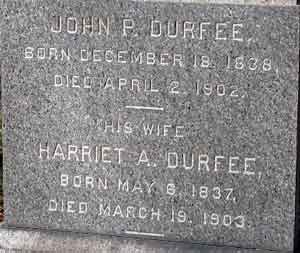
DURFEE, JOHN P. (1838-1902). Private, 8th Regiment, New York State Militia, Company C. A native of New York City, Durfee enlisted there as a private in 1861 and served for three months in Company C of the 8th Regiment. A year later, he enlisted on May 29, 1862, mustered into the same regiment and company, now part of the New York State National Guard, served for three months and mustered out on September 10 at New York City. In 1901, he applied for a pension, application 1,277,763, but there is no certificate number. His last residence was 2534 Edgewood Avenue, New York City. His death was caused by chronic nephritis. Section 74, lot 11767, grave 28.
DURING, CHARLES A. (or A. A.) (1829-1930). Private, 8th Regiment, New York State Militia, Company C. Originally from Frankfort, Germany, During was the son of a bandmaster in Napoleon’s army. He came to the United States in 1849, after a forty-two day voyage by ship and became a naturalized citizen on July 25, 1854. According to the 1860 census, he was a music teacher. At the onset of the Civil War, he enlisted in 1861 at New York City as a private, mustered into Company C of the 8th Regiment where he served for three months, and was discharged at the end of his term.
The 1870 census indicates that he was a music teacher; the census of 1900 states that he was a professor of music. In 1905, his pension application was granted, certificate 1,118,211. As per the census of 1910, he was a musician. At the time he applied for a passport in 1914, he was 6′ tall with blue eyes, gray hair, a moustache, flat nose, covered chin (beard), and fair complexion.
On September 13, 1929, an article in The New York Times, headlined, Pianist, 100 Today, Will Play at Fete, described During’s 100th birthday celebration and gave details about his career. Looking back over his 100 years, During recalled how, as a youth, he met the renowned composer Felix Mendelssohn in Frankfort at a festival given by his father and how that meeting influenced his career. He reminisced, “I remember his grace and charm of manner and the remarkable demonstration he gave of his ability to improvise.” The article went on to say that During gave music lessons to many of Brooklyn’s elite never maintaining a studio but walking to the homes of his students. In addition to confirming his Civil War service, it was noted that During knew President Abraham Lincoln personally. As for tips to achieve longevity, During advised moderation adding that he never drank intoxicating liquors or used tobacco and that he gave up tea and coffee 50 years ago. During played Beethoven sonatas for the guests assembled for his party. He lived to the age of 101, last residing at 600 West 146th Street in Manhattan. His death was attributed to senility. His widow, Marie During, applied for and received a pension in 1930, certificate A-10-2-31. Section 187, lot 18795.
DURSH, HENRY (1829-1885). Private, 82nd New York Infantry, Company G. Originally from Saxony, Germany, Dursh enlisted at New York City as a private on June 1, 1861, mustered immediately into the 82nd New York, and was discharged for disability on April 1, 1862. In 1876, he applied for an invalid pension, application 213,611, but there is no certificate number. His last residence was 55 Atlantic Avenue in Brooklyn where he died by suffocation in a fire. Section B, lot 9895, grave 251.
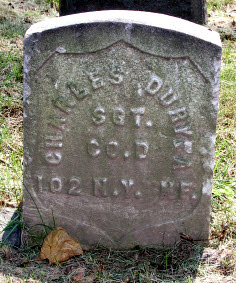
DURYEA, CHARLES W. (1836-1906). Sergeant, 102nd New York Infantry, Company D. A native of New York City, Duryea enlisted there as a private on December 13, 1861, and mustered into the 102nd New York the same day. He re-enlisted on December 30, 1863, was promoted to corporal and sergeant on unknown dates, and was listed as sick on June 1, 1865. Duryea was absent at the time his unit mustered out on July 21, 1865, at Alexandria, Virginia.
He successfully applied for an invalid pension in 1890, certificate 694,325. A member of Frank Head Post #16 of the G.A.R. in Brooklyn, he last lived at 531 Vanderbilt Avenue in Manhattan. Duryea died from nephritis. His wife, Josephine, applied for and received a widow’s pension shortly after his death in 1906, certificate 626,257. Section 93, lot 23, grave 71.
DURYEA, HERMAN B. (1815-1884). Major general. Born in Newtown, New York, his father was a hardware merchant in Brooklyn. He studied law, served a term in the State Legislature, and was District Attorney of Brooklyn. In the 1850s with the rank of major general, he helped to organize Brooklyn regiments, and sent out volunteer regiments during the Civil War. He played a key role in the removal of the “martyr ships” from the Revolutionary War that were in Brooklyn in Wallabout Bay, and the transfer of remains to Fort Greene. He died from phthisis pulmonalis. Section 83, lot 446.

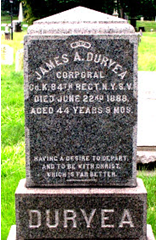
DURYEA, JAMES A. (1843-1888). Corporal, 84th New York (14th Brooklyn) Infantry, Companies C and K; 5th New York Veteran Infantry, Company G. Enlisting and mustering into the 14th as a private at Brooklyn on August 30, 1862, he was promoted to corporal during his service. He was transferred to Company K on September 1, 1863, wounded on May 8, 1864, at an unstated place, and transferred into the 5th New York Veteran Infantry on June 2, 1864. The cause of death was chronic encephalitis. Section 59, lot 743, grave 8.
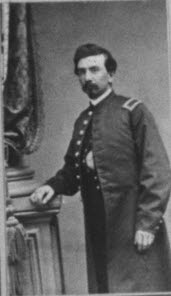
DURYEA, WILLIAM S. (1838-1896). Captain, 6th New York Cavalry, Companies H and F; 2nd Provisional Cavalry, Company E; private, 8th Regiment, New York State Militia, Company G. Duryea first served for three months in 1861 with the 8th Regiment as a private. Subsequently, he enlisted as a first sergeant at New York City on September 19, 1861, and mustered into Company H of the 6th New York Cavalry on October 28. He was promoted to second lieutenant on September 24, 1862; to first lieutenant on December 16, 1863, effective upon his transfer to Company F on February 10, 1864; and became captain on December 1, 1864. On June 17, 1865, he transferred into Company E of the 2nd Provisional Cavalry. He mustered out on August 9, 1865, at Louisville, Kentucky. His last address was 98 North 4th Street in Brooklyn. His widow, Clarissa Duryea, applied for a pension shortly after his death, of “multiple per of colon,” in 1896, certificate 500,389. Section 8, lot 10115.
DURYÉE, ABRAM (1815-1890). Major general by brevet; brigadier general, United States Volunteers; colonel, 5th New York Infantry. Born in New York City, Duryée’s family had a long record of service to the nation. His father and two uncles were officers in the War of 1812 and his grandfather was a soldier in the American Revolution. After making a fortune in the mahogany business, Duryée joined the militia at age 18 and rose to colonel of the 7th Regiment in 1849 where he served until the start of the Civil War. During the Astor Place Riots in 1849, he was hit by stones thrown by the mob resulting in a permanent disability according to Jack D. Welsh, M.D., in Medical Histories of Union Generals (1996, p. 104). (The State Militia was called out to quell a melee at the theater between nativist and anti-British supporters of two actors. Twenty-two were killed and many were injured in the violence.)
In April 1861, he was among the first to recruit volunteers and in less than one week’s time organized the 5th New York, a regiment of 940 men, which became known as “Duryée’s Zouaves.” He was given the rank of colonel on May 25 and led the regiment at the Battle of Big Bethel, Virginia, on June 10 of that year. On September 11, 1861, he was commissioned brigadier general of United States Volunteers to date from August 31. While the 5th was in Baltimore, Maryland, in 1861, he was thrown from his horse, injuring his hip; he spent the next month recuperating in quarters. Subsequently, he commanded his brigade in Virginia at Cedar Mountain, Thoroughfare Gap, Second Bull Run, and Chantilly. In Maryland, he led his brigade at South Mountain, and Antietam. Brigadier General James B. Ricketts, United States Army, in his field report about the engagements from August 17-September 4, 1862, commended Duryée “for his noble conduct at Thoroughfare Gap and his indomitable courage displayed at Bull Run while holding a trying position…” General Meade commended him for his promptness in ascending the mountain in support of the Pennsylvania Reserves at South Mountain and he was recognized again by Ricketts for his “courage under fire” at Antietam. He was officially commended by General Pope for commanding his brigade “with ability and zeal,” and by General McDowell for his gallantry at Thoroughfare Gap. He was wounded twice at Bull Run, sustaining a shell wound under his right arm and a back injury, and after suffering three wounds at Antietam took a 30-day leave. When he returned to his brigade after that furlough, his position was given to an inferior and he could not claim it back. This led to his resignation on January 5, 1863. The 165th and 4th Regiments of the New York National Guard also bore his name. On March 13, 1865, he was brevetted major general of volunteers for distinguished services. At that time, Governor Fenton praised him, “In behalf of the State, allow me to thank you for the gallantry and devotion which induced this conspicuous mention by the general government.” William Swinton, in his History of the Seventh Regiment (1876), lists him on the roll of honor as a veteran of the 7th’s Company B; this service may have occurred before the Civil War.
In 1873, Duryée was appointed police commissioner of New York City, a position he held for many years. During his tenure, he was responsible for routing a gathering of communists from Tompkins Square in 1874. He continued to serve the City as dock master from 1884-1887. After suffering a stroke in 1887, he was totally incapacitated. As per an article about his funeral in The New York Times on October 1, 1890, the attendance of military men honoring his memory was “almost without precedent on any similar occasion.” His pallbearers included Daniel Appleton (see), William H. Riblet (see) and Locke Winchester (see). The attendees included almost the entire 7th Regiment and a large contingent of veterans from the regiment, some of whom served as pallbearers. At Green-Wood, Company B of the 7th Regiment gave him a final salute by firing three volleys and a tribute of “Good Night” was played by a United States Army bugler. His last residence was at 86 West 126th Street in Manhattan. Section 96, lot 618
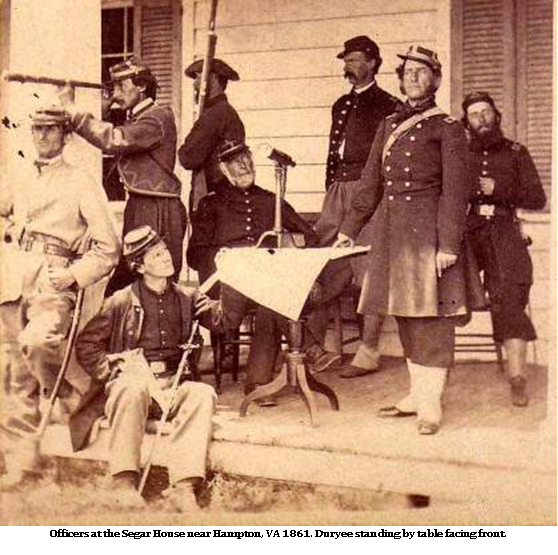
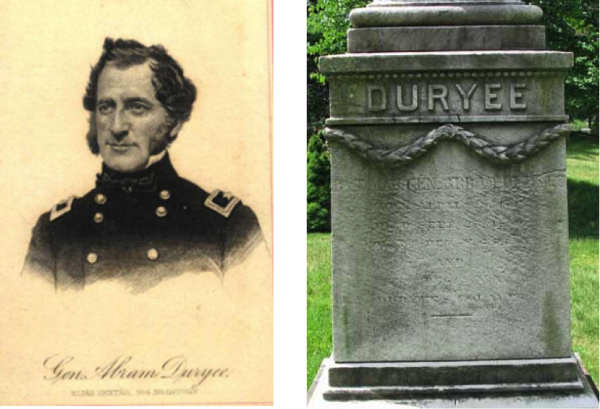
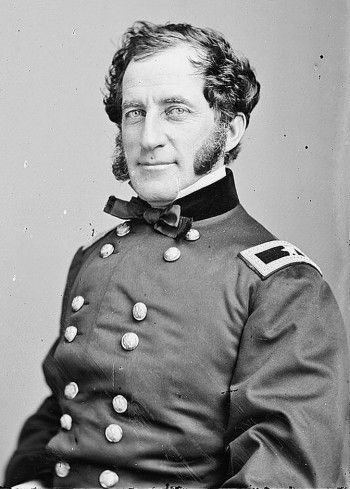
DUSENBERRY (or DUSENBERY), WILLIAM H. (or W. H.) (1837-1905). Unknown rank, 8th Regiment, New York State Militia, Company C; 6th Regiment, New York State National Guard. Dusenberry was born in New York City. According to his pension index card, he served in Company C of the 8th Regiment, New York State Militia Infantry during the Civil War. That document indicates additional service in the 6th Regiment and the 8th Regiment, New York State National Guard. No additional information is available.
The 1880 census indicates that he was married and lived in Brooklyn; the 1884 Brooklyn Directory notes that he was a baker who lived at 652 Gates Avenue in Brooklyn. In 1892, Dusenberry applied for an invalid pension, application 1,085,731, but there is no evidence that it was certified. As per the census of 1900, he was a clerk, had been married thirty-six years and lived with his wife in Brooklyn; the 1901 Brooklyn Directory lists him as a clerk who lived at 363 Fifth Avenue in Brooklyn. He last lived at 550 Franklin Avenue in Brooklyn. His death was attributed to a hemorrhage. Harriet Dusenberry applied for and received a widow’s pension in 1905, certificate 918,676. Section 6, lot 20118, grave 1056.

DUSENBURY, HENRY (1834-1914). Assistant surgeon, 84th New York (14th Brooklyn) Infantry; 132nd New York Infantry. Originally from Albany, New York, he enlisted as a surgeon in the 14th Brooklyn Infantry on March 25, 1863, and was commissioned in as an assistant surgeon five days later. His commission was declined and he was not mustered. Dusenbury then enlisted as an assistant surgeon on April 29, 1863, at Albany, New York, was commissioned into the 132nd five days later, and was discharged for disability on August 1, 1863. As per his pension record, he also served as an assistant surgeon in the Regular Army.
Dusenbury received his medical degree from the College of Physicians and Surgeons at Columbia University in 1866 and practiced in Williamsburg, Brooklyn. In 1907, he applied for and was granted an invalid pension, certificate 1,142,037. A resident of 352 3rd Street in Brooklyn, he died of senility. His obituary in The New York Times confirmed his Civil War service. His widow, Edwina Dusenbury, who is interred with him, applied for and received a pension in 1915, certificate 789,142. Section 49, lot 6446.

DUTCHER, CHARLES H. (1835-1903). Private, 13th Regiment, New York State Militia, Company A. Born in Massachusetts, he served for three months in the 13th New York State Militia in 1861. His last residence was 117 Gates Avenue in Brooklyn. Dutcher died from complications of an ulcer. Section 95, lot 1994.
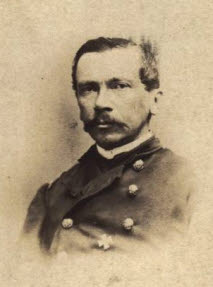
DUYSING, EMIL OTTO (1827-1865). Lieutenant colonel, 41st New York Infantry; major, 15th New York Heavy Artillery, Companies D and L. A native of Marburg, Germany, Duysing enlisted on June 6, 1861, was commissioned into the Field and Staff of the 41st as its lieutenant colonel on that day, and was discharged on September 6, 1861. The 41st, known informally as the DeKalb Regiment, was mainly comprised of recruits of German ancestry, many of whom, like Duysing, fought in the Prussian War against the Danes in 1848-1851. Duysing was a lieutenant in the regular artillery of the Hesse Cassel in Germany which fought against the Danes in 1849.
During the Civil War, he enlisted as a captain in Company D of the 15th New York Heavy Artillery on November 25, 1861, was commissioned in that day, and transferred to Company L in December 1863. On March 6, 1864, he was promoted to major and transferred to staff command. The regiment had been assigned garrison duty in Washington but was transferred to field service in April 1864. Duysing saw action in the severe fighting that marked Grant’s 1864 Virginia offensive. He was wounded by gunshot at Five Forks, Virginia, on March 31, 1865, and died of his wounds on April 21 of that year in Petersburg, Virginia.
Duysing’s funeral at Green-Wood attracted many mourners including those of notable German families, and members of his Masonic lodge in full regalia. The cortege started out from his residence at 192 Atlantic Street in Brooklyn and was joined by the 96th Regiment’s band and members of the 41st and 14th Brooklyn who served with the same division. An ode performed by the Germania Society’s choir and Masonic rituals concluded the proceedings. Section 72, lot 2620.
DYER, LEWIS S. (1845-1878). Private, 3rd New York Light Artillery, Battery B. Originally from New York City, Dyer enlisted there as a private on December9, 1861, and mustered into the 3rd New York Light Artillery that day. Although he gave his age as 18 at the time of his enlistment, he apparently lied about his birth year because census records from 1860 list his age as 15 at that time. He was discharged on March 11, 1865, at Hilton Head, South Carolina. He died from uraemic convulsions. His last residence was 134 West 36th Street in Manhattan. Section 113, lot 16295.
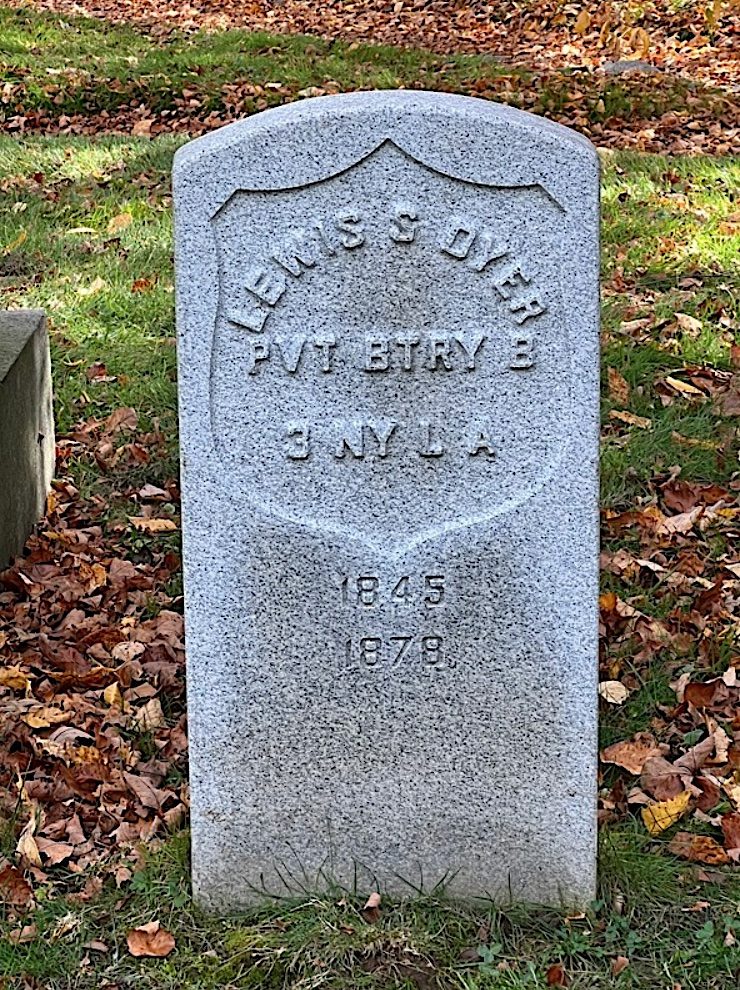
DYKEMAN, EMMETT (or ROBERT EMMETT) (1843-1920). Private, 109th New York Infantry, Company D; 51st New York Infantry, Company D. After enlisting as a private at Binghamton, New York, on January 1, 1864, he mustered into the 109th that day, transferred to the 51st on May 31, 1865, and mustered out on July 25, 1865, at Alexandria, Virginia. By trade, he was a carpenter and contractor after the War. The G.A.R. shield on his tombstone is testament to the pride he took in military service. He applied for and received an invalid pension in 1915, certificate 1,111,370. He last lived at 126 Sterling Place in Brooklyn. Dykeman’s death was attributed to nephritis. His widow, Harriet Dykeman, received a pension in 1921, certificate 896,550. Section 172, lot 114
